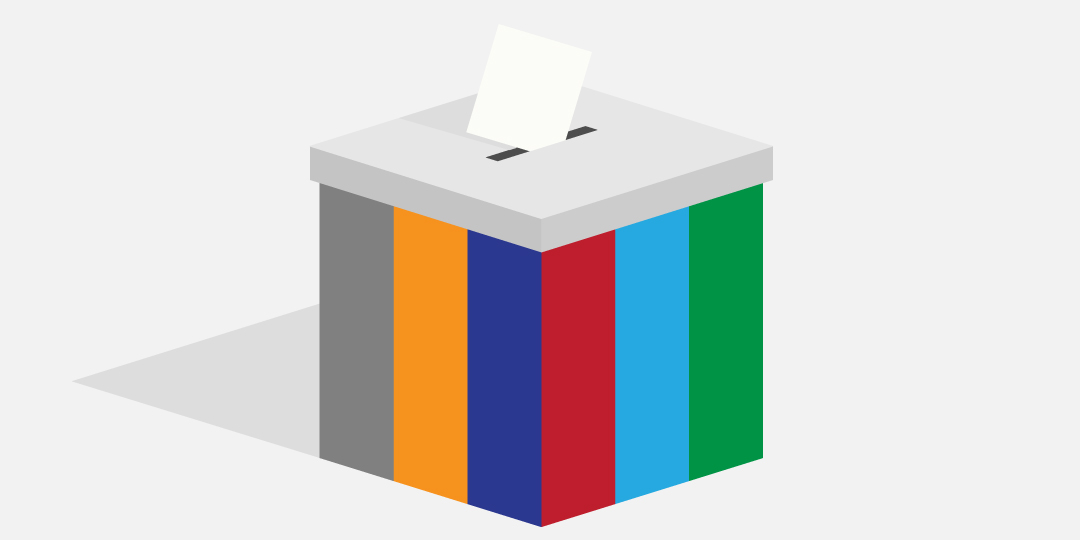
What if an election were held today? How the votes are counted determines our country’s future.
If the federal election were held today, 41% percent of the popular vote would hand Pierre Poilievre’s Conservatives 60% of the seats and 100% of the power.
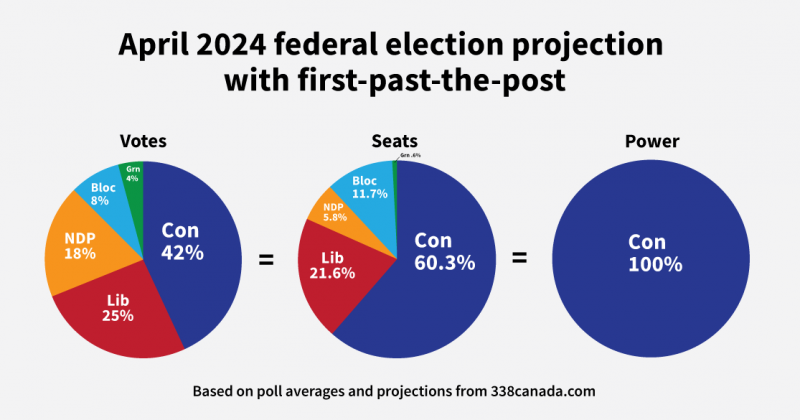
Based on projections from tooclosetocall.ca and poll averages from 338canada.com as of April 10, 2024
With first-past-the-post, the majority of Canadian voters would be shut out of decision-making for the next four years.
Canada’s Prime Minister’s Office has a stranglehold on power to an extent that makes us unique in the OECD. This means our first-past-the-post voting system essentially hands the levers of power to one leader and a bunch of unelected party strategists.
What if the election were held today with proportional representation?
First, an important qualification: Since voters will vote differently with proportional representation, no one can say with certainty what the legislature would look like with PR.
All we have to go on is voters’ preferences under first-past-the-post. Based on current levels of support for each party, the results of an election today with proportional representation are shown below:
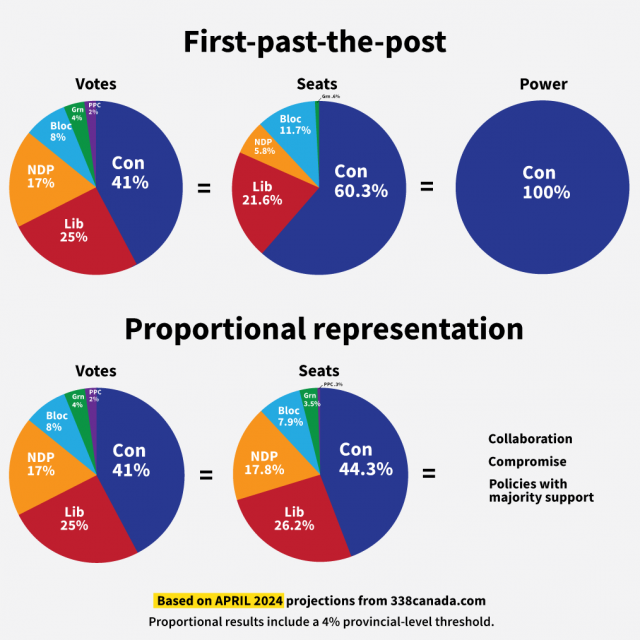
Based on projections from tooclosetocall.ca and poll averages from 338canada.com as of April 10, 2024. Proportional results include a 4% provincial-level threshold.
The most obvious difference is that Canadians would get what they voted for.
The percentage of seats each party would get in Parliament closely matches their popular support.
That’s fair. And it’s how most modern democracies run their elections.
With proportional representation, no matter where you live or who you vote for, your vote counts. Almost every voter matters to the outcome.
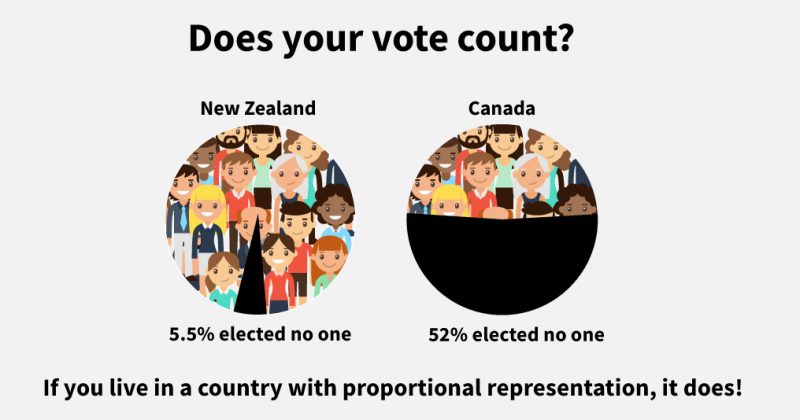
Voters who are now shut out of meaningful representation by first-past-the-post, such as Conservative voters in downtown Toronto and Liberal voters in rural Alberta, will consistently be able to elect MPs to represent them.
Voters in every region will usually have MPs in the governing party and on the opposition benches.
Having MPs that better represent the diversity within each region may help mitigate the tensions from the rural-urban divide and reduce regional polarization that strains our national unity.
The final difference―the game-changer―is that no party will have majority control with a minority of the vote.
This simply reflects what Canadians are saying with their ballots. In fact, the last time more than 50% of voters backed a single party was in 1984.
All of the benefits above are not conjecture nor wishful thinking. They are guaranteed with proportional representation for Canada.
Although nobody can predict the future, since over 80% of OECD countries use proportional systems, we have decades of research to show us what changes we can expect when every vote counts. These include:
- Who shows up to vote: Turnout in countries with PR is higher on average than in countries with first-past-the-post.
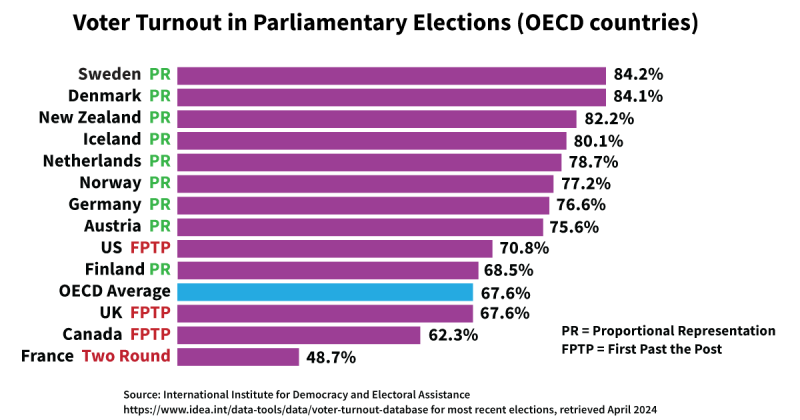
In an era when voter turnout is declining around the world, there is no guarantee that switching to proportional representation would increase voter turnout in Canada. However, the New Zealand experience gives some reason for optimism: after that country made the switch, turnout increased in formerly “safe seats” and among youth. That suggests that people who felt their votes were wasted in a first-past-the-post system were more empowered to participate with PR.
- More voter choice: First-past-the-post can give a couple of parties a near-monopoly on representation and power. When voters for third and smaller parties can gain fairer representation, the system usually becomes more competitive.
While PR systems for Canada aren’t likely to produce a large number of new parties, it’s reasonable to expect that voters will have more real choice.
Under first-past-the-post, some of our “big tent” parties are marriages of convenience. The only thing holding them together is the lure of unbridled power with first-past-the-post.
It’s plausible, for example, that proportional representation may mean a return of a party like the Progressive Conservatives. - A less polarized political culture: Research shows that proportional representation reduces partisan polarization.
Canadians are becoming more polarized along party lines, whipped up by politicians into what journalist Justin Ling called “agitated clusters of comforting rage”. According to the Economist’s Democracy Unit, Canada’s politics are starting to look more like the United States.
By strengthening our multi-party system and making cooperation between parties the norm, proportional representation could reverse this dangerous trend. - Better outcomes on a wide range of issues that Canadians care about: From economic growth to health to environment, over the long run, countries with proportional representation outperform countries with winner-take-all voting systems while delivering more of what voters want.
The vast majority of people don’t trust politicians―for good reasons. Too much power in the hands of a few is a dangerous thing.
Yet we can only solve our long-term problems with political leadership.
We need our voices to be heard in Parliament. We need our MPs to find common ground and to work together.
First-past-the post fails voters on all these fronts. A fairer, more inclusive and more cooperative political system is critical.
